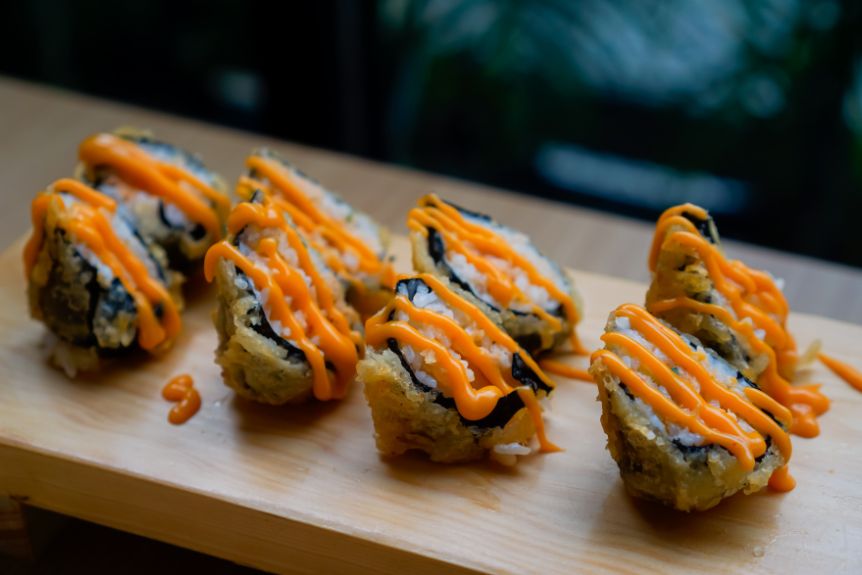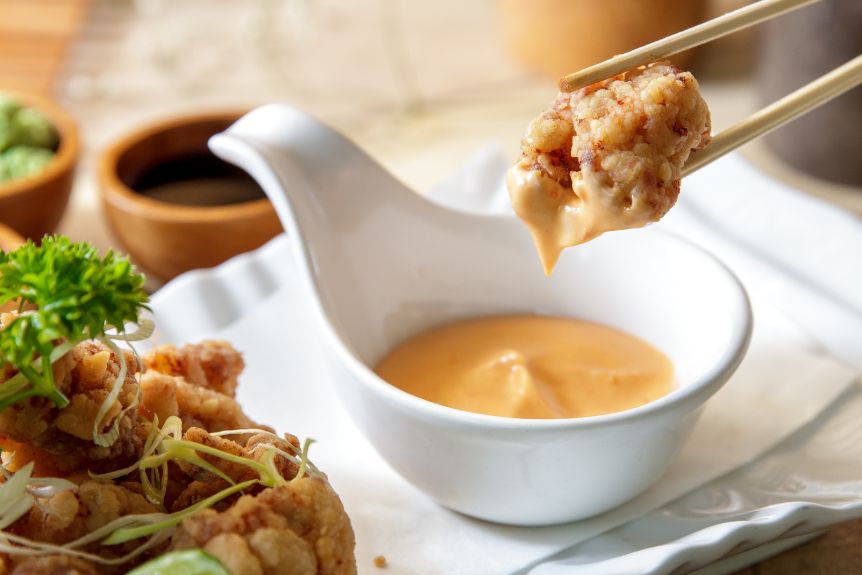Get ready for a whole new mayo experience with Japanese mayonnaise. It’s a flavor adventure that might just change your mind about mayonnaise altogether. This isn’t your usual mayo; it’s something special that could win over even those who aren’t big fans of regular mayonnaise.
Its creamy texture and rich, one-of-a-kind flavor really make a difference, taking meals to a whole new level of yummy. But don’t just think about using it in sandwiches and salads – there’s so much more you can do with it!
In Japan, it’s a versatile staple that adds a tangy kick to traditional cuisine and can even transform your favorite Western recipes.
Join us as we explore the world of Japanese mayonnaise, uncovering its secrets, exploring its uses, and revealing tips for selecting the best product. Get ready to embark on a culinary adventure that will leave you craving more!
The Origins of Japanese Mayonnaise
Japanese mayonnaise, a creamy and tangy condiment, originated in 1925 when Toichiro Nakashima introduced the nation to its unique blend. He crafted a recipe that significantly diverged from Western versions, focusing on ingredients that catered to the Japanese palate.
You’ll appreciate knowing that this isn’t just any condiment. The distinct flavor comes from using only egg yolks instead of whole eggs and a precise blend of vinegar, which gives it a richer, more nuanced taste. It’s a testament to the meticulous care and attention to detail that defines Japanese culinary tradition.
What sets it apart is the method of production and the quality of ingredients. Rice vinegar, used in its preparation, offers a milder acidity compared to the vinegars typically used in Western mayonnaise.
This choice is deliberate, aiming to complement rather than overpower the flavors of dishes. You’re in control when you choose Japanese mayonnaise; it’s about enhancing, not masking, the natural taste of your food.
Embracing this condiment is embracing a piece of culinary innovation. It’s an invitation to elevate your dishes with a product born from a desire to create something uniquely suited to the Japanese taste, yet universally loved.
Key Ingredients and Flavors
Having learned about its origins, let’s explore the key ingredients and flavors that give Japanese mayonnaise its distinctive taste.
At the heart of its unique flavor profile are egg yolks, vinegar, and a touch of MSG, which together create a rich, umami-packed condiment unlike any other.
You’ll notice that unlike Western mayonnaise, which often uses whole eggs, Japanese mayo emphasizes egg yolks. This choice results in a creamier texture and a deeper, more luxurious taste.
The type of vinegar used also plays a crucial role. Instead of distilled vinegar, Japanese mayonnaise typically incorporates apple cider or rice vinegar, offering a subtle sweetness and a milder acidity.
Moreover, the inclusion of MSG, a flavor enhancer, contributes to its umami depth, making it a versatile ingredient that enhances the taste of various dishes.
It’s this careful balance of ingredients that allows you to wield control over your culinary creations, adding complexity and richness with just a dollop of mayo.


Culinary Uses in Japanese Cuisine
Diving into its culinary uses, you’ll find that Japanese mayonnaise acts as a transformative ingredient in many traditional and modern Japanese dishes. It’s not just a condiment; it’s a flavor enhancer that you can wield to elevate your cooking.
With its rich, slightly tangy taste, it blends seamlessly into the backdrop of various recipes, providing a velvety texture that’s hard to replicate.
You’ve got the power to transform simple vegetables into a delectable salad by mixing them with this creamy mayonnaise. It’s a staple in potato salads, often found at Japanese BBQs, where its unique flavor profile complements the smoky meats perfectly.
Don’t stop there; spread it on your sushi rolls or drizzle over takoyaki and okonomiyaki to introduce an unexpected depth of flavor that’ll have everyone asking for your secret.
Embrace the versatility of Japanese mayo by incorporating it into your marinades. It’ll not only tenderize but also add a subtle richness to your meats and seafood.
Remember, you’re in control. Experiment with the amounts to suit your taste, and watch as it transforms your dishes from good to extraordinary.
Incorporating Japanese Mayonnaise Into Western Dishes
You’ll find that integrating Japanese mayonnaise into Western dishes can effortlessly elevate familiar flavors with an unexpected twist. This creamy condiment, known for its rich umami taste, turns the ordinary into the extraordinary.
Imagine your classic potato salad. By replacing traditional mayonnaise with its Japanese counterpart, you’ll unlock a depth of flavor previously unattainable, making a simple side dish stand out.
Take control of your burgers by smearing them with Japanese mayonnaise. The subtle tang and umami kick enhance the meat, creating a mouthwatering experience. You’re not just making a burger; you’re crafting a culinary delight.
Don’t stop there. Mix it into your pasta salads. The silky texture of Japanese mayonnaise binds ingredients together more cohesively, ensuring each bite is as flavorful as the last. You’ll notice how it subtly transforms the dish, making it richer and more satisfying.
Lastly, elevate your dips. Adding this mayonnaise to your favorite recipes, like guacamole or artichoke dip, introduces a velvety consistency and a complexity of flavor that you’ll be proud to serve.
You’re not just cooking; you’re innovating, taking control of your kitchen by infusing traditional Western dishes with a touch of Japanese sophistication.
Tips for Choosing and Storing
Selecting the right Japanese mayonnaise and properly storing it are essential steps to maximize flavor and shelf life.
When you’re choosing a brand, prioritize ones that use quality ingredients, such as rice vinegar and egg yolks, for that authentic taste. You’ll find these details on the product label, so don’t skip reading it.
Opt for mayonnaise that comes in a sealed, opaque bottle to protect it from light, which can degrade its quality.
Once you’ve brought your mayonnaise home, it’s crucial to store it correctly. Always keep it in the refrigerator, not in the door, but in the main compartment, where the temperature is more stable.
This practice will ensure your mayonnaise remains fresh and safe to consume for as long as possible.
An opened bottle should ideally be used within a month, even if the expiry date is further out. Trust your senses too; if it smells or tastes off, it’s better to be safe and discard it.
Conclusion
You now know about the rich heritage behind Japanese mayonnaise, its distinct ingredients, and the vibrant flavors it brings to both traditional and modern dishes.
Whether you’re sprinkling it on sushi or mixing it into your favorite Western recipe, this versatile condiment can elevate any meal. Remember to choose a brand that suits your taste and store it properly to keep its unique flavor intact.
However, not everyone may agree that Japanese mayonnaise is a must-have in the kitchen. Some may argue that its tangy and creamy taste can overpower the natural flavors of certain dishes. While it’s true that Japanese mayonnaise has a strong flavor profile, it’s all a matter of personal preference.
What do you think? Do you love the unique flavor of Japanese mayonnaise, or do you prefer a different type of mayo? Leave a comment and let’s know your thoughts!
Regardless if you’re a fan or not, there’s no denying the cultural significance and versatility of this beloved condiment. Dive in and experiment – your taste buds will thank you!




Konnichiwa! (Hello!) I'm Pat Tokuyama, a Japanese tofu cookbook author, who travels for music, food, and adventure. If you like Japanese tea, checkout some of the newestorganic japanese tea, matcha bowls and noren and more!
** Curious about the Plant Based Japanese Cooking Club? ** Learn more here!